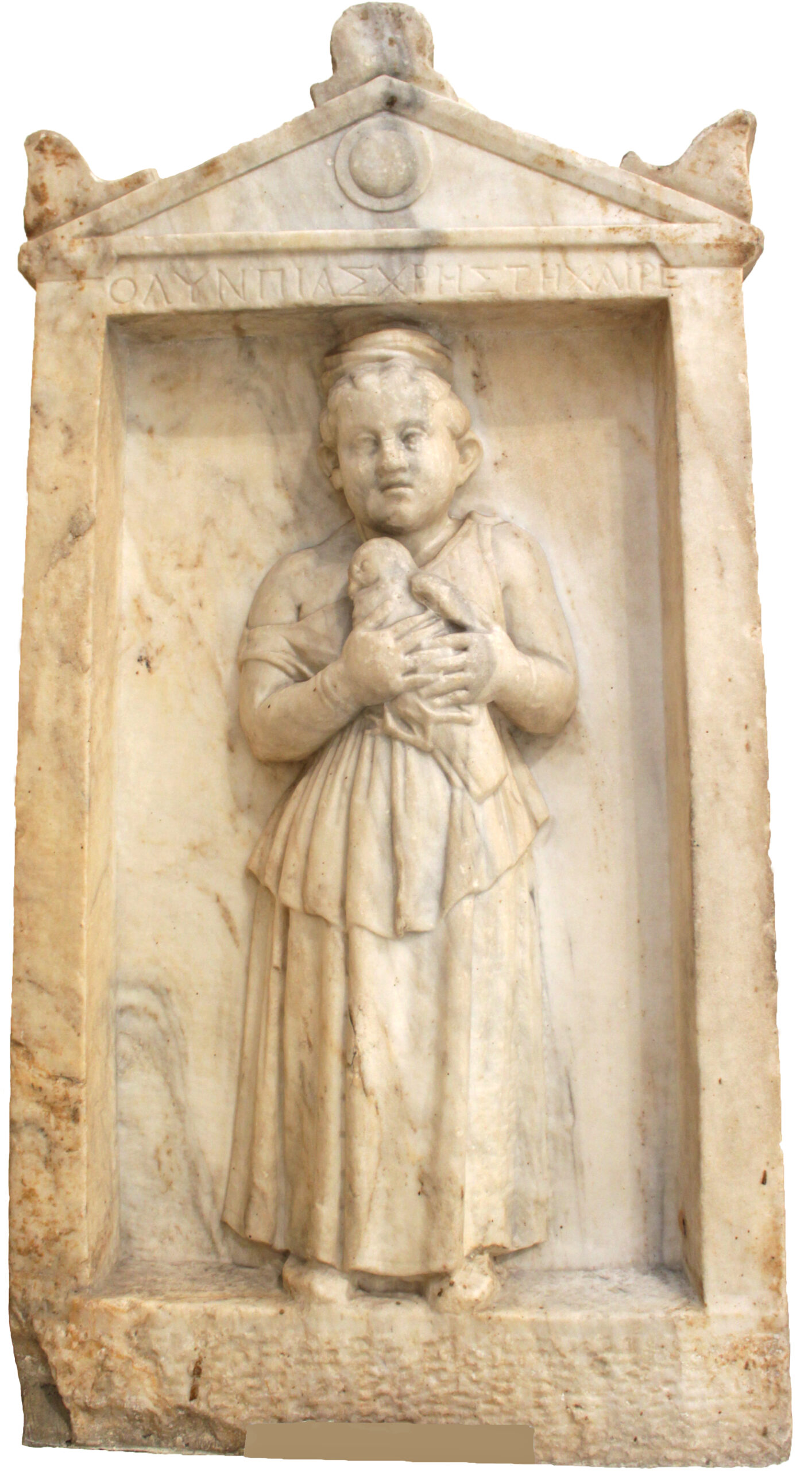Exhibit of the month
A tender hug
The Grave Stele of Olympias
National Archaeological Museum
Sculpture Collection Inv. Nr. Γ 3955
Provenance: Athens
Measurements: Height: 1m. Width: 0,51m.
Chronology: Roman period, in the time of Hadrian (AD 117-138)
Display place: Room 32
The grave stele of little Olympias, has the form of a naiskos with pilasters, crowned by a pediment with palmette acroteria. At the center of the tympanum, a relief shield is depicted. An inscription on the epistyle provides the name of the dead girl “Kind Olympias farewell”. Little Olympias is standing frontally wearing a peplos, girt at the waist, that slides down exposing her right shoulder. Her hair is drawn back in small clusters and gathered in a wide bun at the top of the head. This hairstyle implies the young age of the depicted persons whether they are little girls or young goddesses. Olympias has a round face with chubby cheeks. With her plump hands she holds a dove with folded wings tightly to her breast. If this depiction is to be interpreted symbolically, and not as that of a child with its casual toy, then maybe the dove could be viewed as the little companion of Olympias’ soul, which is also hovering during her journey to the Underworld.
Dating from the Archaic to the Roman period, there is a number of grave reliefs depicting children, that were placed over their graves recording also their names . Depictions of boys or girls holding birds, usually doves, which probably accompanied the children in their everyday life, were particularly popular. The tender affection and love that the children show to their winged friends, transforms those grave reliefs into the most sensitive depictions of children ever known to us from antiquity.
At the National Archaeological Museum, one can follow the development of the grave reliefs with children holding birds, from the classical, to the Roman times. Philokles from the Demos of Flya (today known as Chalandri) offers a bird to his little son Dikaios, who is reaching out his right hand to grab it. The young Athenian girl Mnesagora gives a dove to her brother Nikochares, and he, still being a toddler, attempts to stand up and reach it. Likewise, Chairestrate gives a bird probably to her younger brother, Lysandros. Euempolos from Piraeus is depicted on the right of the stele, seated on a chair. He holds out a bird to two children, who stand in front of him, a boy, who touches his father’s left hand and a somewhat older girl. To the 4th century B.C. belongs the stele of Archestrate, found at Markopoulo in Attica. Archestrate is depicted seated, to the right of the stele. With her right hand she probably takes a jewel from the pyxis presented to her by a young woman. Standing next to her feet, her young daughter looks affectionately at her mother, holding a bird in her right hand.
Infant mortality was very high in ancient Greece; as far as we know, only one out of three infants survived, of whom only half managed to reach adulthood. The loss of children did not only bring sorrow and grief to the family, but at the same time was considered bad fortune for the city, since children were its future, who would ensure, as adults, its protection and survival.
Dr. Wanda Papaefthymiou
Selected Bibliography
Ν. Kaltsas, Sculpture in the National Archaeological Museum (Athens 2002) 353, Kat. Nr. 746.
Α.V. Karapanagiotou, Γυναίκα και κοινωνική προβολή στην Αθήνα. Η μαρτυρία των επιτύμβιων αναγλύφων της ύστερης ελληνιστικής και της αυτοκρατορικής περιόδου (Volos 2013) 65-67, 176, cat. no. 216, pl. 42.
D. von Moock, Die figürlichen Grabstelen Attikas in der Kaiserzeit (Mainz 1998) 151, αρ. 343, πίν. 52a.
On depiction of children on attic funerary monuments
O. Hirsch-Dyczeck, Les Représentations des enfants sur les stèles funéraires attiques (Warsaw 1983).
J.H. Oakley, “Death and the Child” στο: J. Neils – J.H. Oakley (επιμ.) Coming of Age in Ancient Greece, Exhibition in Hood Museum of Art, New Hampshire 23 August – 14 December 2003 (New Hampshire 2003) 163-194.
H. Rühfel, Das Kind in der griechischen Kunst von der minoisch-mykenischen Zeit bis zum Hellenismus (Mainz 1984).


